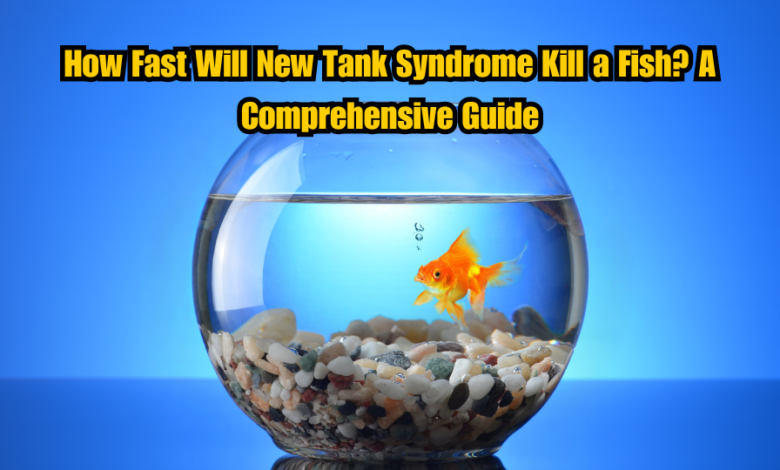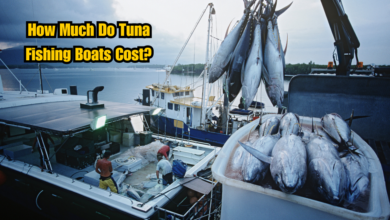How Fast Will New Tank Syndrome Kill a Fish? A Comprehensive Guide

New tank syndrome is a critical issue in the world of aquariums, especially for novice fishkeepers. This problem arises when a newly set-up aquarium lacks the essential balance of beneficial bacteria to properly process the waste produced by fish. The result is often a dangerous spike in ammonia and nitrite levels, which can be deadly to fish if not managed properly. In this guide, we explore the details of new tank syndrome, its causes, symptoms, and, most importantly, how fast it can kill a fish.
What is New Tank Syndrome?
New tank syndrome refers to the phenomenon where ammonia and nitrite levels rise rapidly in a new aquarium due to the absence of an established bacterial colony. These bacteria are responsible for converting toxic ammonia, excreted by fish and produced from decaying matter, into less harmful nitrite, and finally into nitrate. In a newly set-up tank, these bacteria haven’t had time to develop, resulting in toxic water conditions that can kill fish quickly.
Understanding the Nitrogen Cycle
At the heart of new tank syndrome is the nitrogen cycle, a natural process that occurs in all aquatic environments. The cycle involves three key stages:
- Ammonia (NH3): Produced by fish waste, uneaten food, and decaying plants. Even small amounts of ammonia can be toxic to fish.
- Nitrite (NO2): Ammonia is broken down into nitrite by nitrifying bacteria. Nitrite is still toxic to fish but less harmful than ammonia.
- Nitrate (NO3): Nitrite is further broken down into nitrate, which is far less toxic and can be removed through regular water changes or absorbed by live plants.
In a new tank, this bacterial process hasn’t fully developed, leading to dangerous spikes in ammonia and nitrite levels, which are the primary causes of new tank syndrome.
How Fast Can New Tank Syndrome Kill a Fish?
The speed at which new tank syndrome can kill a fish depends on several factors, including the species of fish, water temperature, pH levels, and the concentration of toxic substances like ammonia and nitrite. However, in many cases, fish can start showing signs of distress within 24 to 48 hours of being introduced to a poorly cycled tank.
- Ammonia Poisoning: Fish exposed to high levels of ammonia can suffer from ammonia poisoning, which can result in death within a few days. Ammonia burns the gills of fish, making it difficult for them to breathe. In extreme cases, fish can die within hours of being exposed to high concentrations.
- Nitrite Poisoning: Nitrite interferes with the fish’s ability to transport oxygen in the blood, a condition known as brown blood disease. This can cause fish to gasp for air at the surface, become lethargic, and eventually die if not addressed.
Note: Some hardy species, like certain types of cichlids or goldfish, might survive for a longer period, but even they will eventually succumb to prolonged exposure to ammonia and nitrite if the problem isn’t corrected.
Symptoms of New Tank Syndrome in Fish
Recognizing the symptoms of new tank syndrome is crucial to saving your fish. Common signs include:
- Gasping for air at the surface of the water (due to ammonia or nitrite poisoning)
- Lethargy and sluggish movement
- Red or inflamed gills
- Clamped fins (where the fish’s fins are held close to the body)
- Loss of appetite
- Unusual behavior, such as erratic swimming or hiding
- Cloudy eyes and discoloration
If you notice any of these symptoms, immediate action is needed to prevent further harm to your fish.
Preventing New Tank Syndrome
The best way to avoid new tank syndrome is to properly cycle your tank before introducing any fish. Tank cycling allows the beneficial bacteria to establish a colony and process ammonia and nitrite safely. Here’s how to do it:
1. Fishless Cycling
The most humane method to cycle your tank is fishless cycling. This involves adding an ammonia source (such as pure ammonia or fish food) to the tank and allowing the bacteria to develop naturally over a few weeks. Test the water regularly for ammonia, nitrite, and nitrate levels to ensure the cycle is progressing.
2. Use of Bacteria Supplements
Many aquarium hobbyists use bacteria supplements, which are commercially available products containing live nitrifying bacteria. Adding these to your tank can speed up the cycling process, allowing you to add fish sooner without risking their health.
3. Partial Water Changes
During the cycling process, perform regular partial water changes (20-30%) to reduce ammonia and nitrite levels. However, be careful not to change too much water, as this can slow down the establishment of beneficial bacteria.
4. Add Fish Gradually
Once your tank is cycled, introduce fish slowly and in small groups. This prevents sudden spikes in ammonia, which can occur if too many fish are added at once.
5. Monitor Water Quality
It’s essential to test your water frequently using an aquarium test kit. Regularly check for ammonia, nitrite, and nitrate levels, especially during the first few weeks after setting up a new tank. Keeping a close eye on water quality will help you address any issues before they become lethal to your fish.
Treating New Tank Syndrome
If your tank is already experiencing new tank syndrome, there are steps you can take to mitigate the damage and save your fish:
1. Immediate Water Changes
Perform large water changes of 25-50% immediately to reduce ammonia and nitrite levels. Use a good quality dechlorinator to remove chlorine and chloramines from tap water before adding it to your tank.
2. Add an Ammonia Neutralizer
Products like ammonia neutralizers can help bind the toxic ammonia and render it harmless to fish. However, these should only be used as a temporary solution until your tank’s nitrogen cycle is established.
3. Increase Aeration
Boosting oxygen levels in the tank can help fish breathe easier while they recover from ammonia or nitrite poisoning. Adding an air stone or increasing the flow from your filter can improve aeration.
4. Use Nitrifying Bacteria
Adding live nitrifying bacteria can help establish the nitrogen cycle faster and reduce ammonia and nitrite levels. Look for products that contain both Nitrosomonas and Nitrobacter bacteria, as both are essential for a healthy nitrogen cycle.
The Role of pH in New Tank Syndrome
Water pH plays a significant role in how toxic ammonia is to your fish. Ammonia becomes more toxic in alkaline water (pH above 7.0) and less toxic in acidic water (pH below 7.0). If you’re experiencing high ammonia levels, you may want to check your pH and adjust it if necessary. However, be cautious when altering the pH, as sudden changes can further stress your fish.
Long-Term Prevention of New Tank Syndrome
Once your tank is fully cycled, there are several long-term measures you can take to prevent future cases of new tank syndrome:
1. Regular Maintenance
Perform weekly water changes of 10-20% to remove nitrates and other waste products. Clean the tank, gravel, and filter regularly to prevent the buildup of organic material.
2. Avoid Overfeeding
Overfeeding your fish is one of the most common causes of high ammonia levels. Uneaten food decays and produces ammonia, so only feed your fish what they can eat in a few minutes.
3. Maintain a Healthy Fish Population
Overstocking your tank can lead to excess waste and an overwhelmed filtration system. Follow the general rule of 1 inch of fish per gallon of water to avoid overcrowding.
4. Monitor Water Parameters
Even in a well-established tank, it’s important to regularly check the water parameters. Keep an eye on ammonia, nitrite, nitrate, pH, and temperature to ensure they remain within safe levels for your fish.
Conclusion: Protecting Your Fish from New Tank Syndrome
New tank syndrome can be a silent killer in newly established aquariums, but with proper care and attention, it can be avoided. Understanding the nitrogen cycle, cycling your tank before adding fish, and maintaining proper water quality are the keys to preventing new tank syndrome from killing your fish. If your fish show any signs of distress, immediate action through water changes and ammonia neutralizers can help save their lives.
For more in-depth aquarium care tips, explore trusted aquarium hobbyist resources like Fishkeeping World and Aquarium Source.
By taking these proactive steps, you can ensure a healthy environment for your fish and enjoy a thriving aquarium for years to come.




